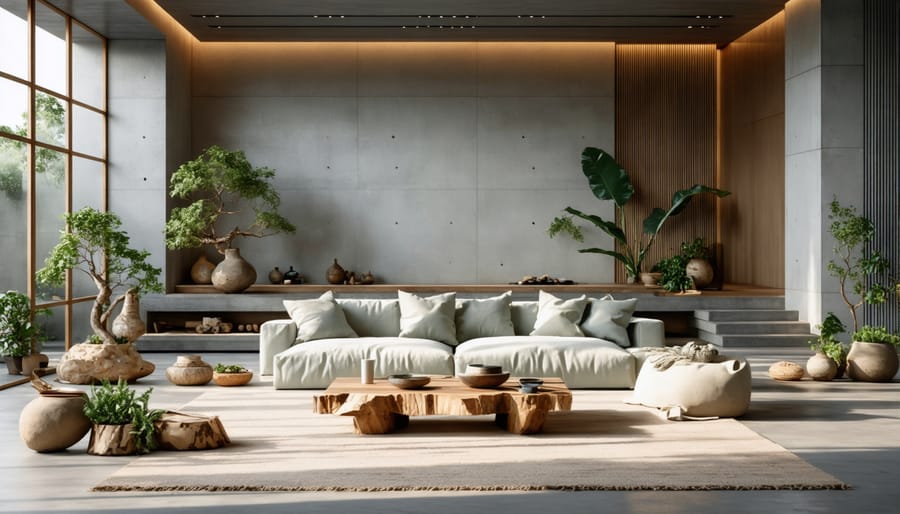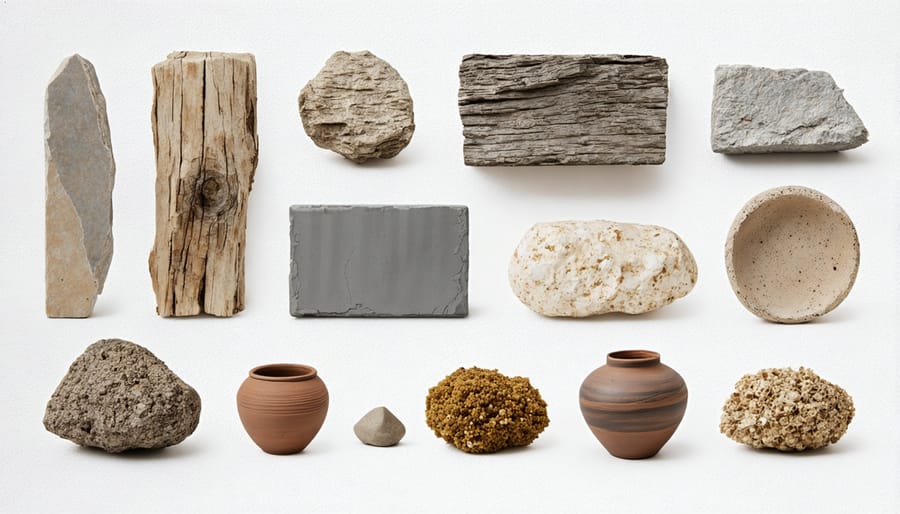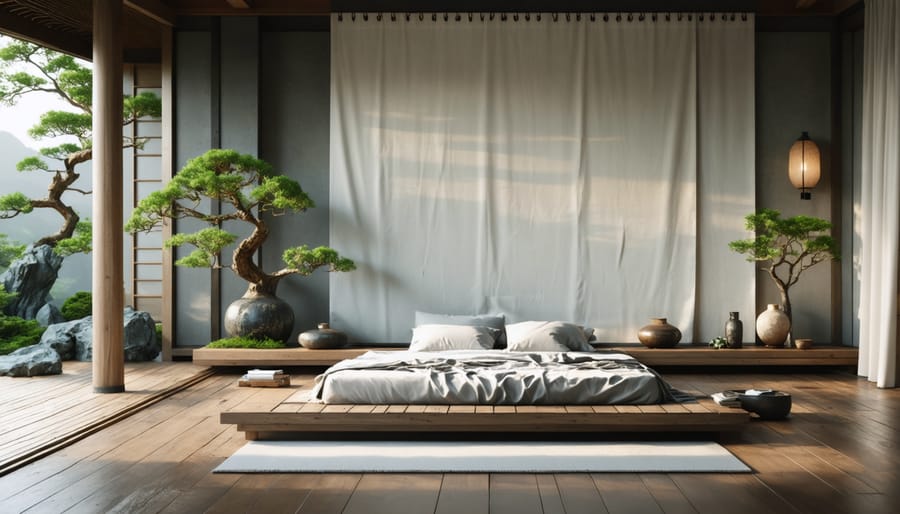Embrace the profound simplicity of modern wabi-sabi by blending raw materials with minimalist design principles. This centuries-old Japanese aesthetic, characterized by finding beauty in imperfection, has evolved into a compelling answer to today’s overwhelming push for sterile perfection in interior design. In modern homes, wabi-sabi manifests through natural materials like unfinished wood, handmade ceramics, and organic textiles, creating spaces that feel both contemporary and timeless.
Unlike traditional minimalism’s stark approach, modern wabi-sabi interiors celebrate the authenticity of weathered surfaces, irregular patterns, and the subtle patina that develops over time. This design philosophy transforms living spaces into peaceful sanctuaries where imperfections aren’t just accepted – they’re celebrated as markers of authenticity and life lived well.
Today’s interpretation of wabi-sabi seamlessly integrates with modern amenities while maintaining its core principles of simplicity, naturality, and intimacy. From exposed concrete walls to hand-thrown pottery displayed alongside sleek furniture, this approach creates spaces that feel both grounded and sophisticated, offering a thoughtful antidote to the digital age’s perpetual pursuit of perfection.
The Essence of Modern Wabi-Sabi Design
Key Principles of Wabi-Sabi in Modern Spaces
The beauty of wabi-sabi lies in three fundamental principles that seamlessly blend with modern design sensibilities. First, simplicity (kanso) forms the foundation of this aesthetic, encouraging us to declutter our spaces and focus on items that truly matter. Think clean lines, minimal décor, and thoughtful furniture placement that allows rooms to breathe.
The second principle centers on incorporating natural elements in interior design. Raw materials like unfinished wood, stone, and clay bring authentic texture and warmth to contemporary spaces. Consider exposed wooden beams, handmade ceramics, or natural fiber textiles to create a genuine connection with nature.
Perhaps most liberating is the third principle: embracing imperfection (kintsugi). Unlike the pursuit of flawless modern design, wabi-sabi celebrates the beauty in wear and aging. That weathered leather chair, slightly uneven handmade vase, or naturally worn wooden table all tell a story and add character to your space. This principle helps create homes that feel lived-in and deeply personal, rather than sterile showrooms.
The Modern Interpretation
Today’s designers are reimagining wabi-sabi for contemporary spaces while staying true to its core principles. Rather than strictly adhering to traditional Japanese aesthetics, modern interpretations embrace a fusion of old and new. You’ll find natural materials like concrete and weathered wood paired with sleek, minimalist furniture, creating an engaging dialogue between rustic and refined elements.
Contemporary wabi-sabi often incorporates sustainable materials and handcrafted pieces, reflecting both environmental consciousness and appreciation for imperfection. Designers might choose recycled materials, locally sourced stone, or reclaimed wooden beams to add character to modern spaces. The color palette typically features earth tones and muted naturals, but with occasional bold accents that add a contemporary twist.
Technology is thoughtfully integrated, often concealed behind natural materials or incorporated in ways that don’t disturb the overall sense of calm. The goal is to create spaces that feel both timeless and lived-in, where modern convenience meets intentional imperfection. This modern take preserves the philosophy’s essence while making it accessible and practical for today’s lifestyle needs.

Creating Your Wabi-Sabi Space
Materials and Textures
In modern wabi-sabi design, the selection of materials plays a crucial role in achieving that perfect balance between rustic charm and contemporary elegance. Natural, imperfect materials are the foundation of this aesthetic, helping to create a cozy atmosphere while celebrating authenticity.
Wood is arguably the most important material in wabi-sabi interiors. Opt for unfinished or lightly treated wood with visible knots, grain patterns, and natural aging. Reclaimed timber, particularly for furniture and accent pieces, adds character through its weathered appearance and rich history.
Clay, concrete, and stone bring earthy textures that ground the space. Consider exposed concrete walls, handmade ceramic vessels, or stone countertops with natural variations. These materials age beautifully, developing unique patinas over time that enhance their wabi-sabi appeal.
Textiles should be natural and tactile – think raw linen, undyed wool, and handwoven cotton. Choose pieces with subtle irregularities in weave or color, avoiding perfectly uniform patterns. Layer these materials with rough-hewn pottery, oxidized metals, and handmade paper elements to create depth and visual interest.
For modern touches, incorporate minimal amounts of glass, brushed metals, or smooth surfaces. The key is to balance these contemporary elements with more organic materials, ensuring they complement rather than overshadow the wabi-sabi essence of your space.

Color Palettes
In modern wabi-sabi design, color plays a vital role in creating that perfect balance between serenity and lived-in comfort. The key lies in embracing natural color palettes that mirror the earth’s organic beauty while maintaining a contemporary edge.
Start with a foundation of warm neutrals like soft whites, gentle beiges, and subtle grays – these colors create a calm, welcoming atmosphere while highlighting the natural imperfections that wabi-sabi celebrates. Think of the varying shades you might find in unglazed pottery or weathered wood.
Layer these base tones with deeper earth colors: rich clay reds, forest greens, and deep browns. These darker hues add depth and ground the space, much like the shadows in a zen garden. For a modern twist, incorporate muted versions of traditionally bold colors – think sage instead of emerald, terracotta rather than bright orange.
Avoid stark contrasts or artificially bright colors that might disturb the peaceful atmosphere. Instead, opt for colors that seem to melt into one another, creating a harmonious flow throughout your space. Consider the subtle color variations in natural materials like stone, linen, and aged copper – these provide perfect inspiration for your palette.
Remember, in wabi-sabi design, colors should feel lived-in and slightly worn, as if they’ve been gently faded by time and sunlight. This approach creates spaces that are both timeless and deeply personal.
Furniture and Decor Selection
When selecting furniture and decor for a modern wabi-sabi space, embrace pieces that tell a story through their imperfections and natural character. Look for handcrafted items made from raw materials like unfinished wood, stone, or clay. These elements not only add authenticity but also align with sustainable home decor choices that respect both tradition and our environment.
Consider incorporating weathered wooden benches, hand-thrown ceramic vessels, or naturally aged metal fixtures. The key is to find pieces that showcase their journey through time – perhaps a reclaimed wood coffee table with visible knots and grain patterns, or a slightly asymmetrical handmade vase. Modern interpretations might include minimalist furniture with organic shapes, or contemporary pieces crafted from natural materials.
Mix textures thoughtfully: rough stonework against smooth concrete, raw silk beside natural linen, or oxidized metal complementing unglazed pottery. When choosing larger furniture pieces, opt for simple, clean lines that don’t overwhelm the space but still maintain character through their materials or subtle details.
Remember that each piece should serve a purpose while contributing to the overall sense of tranquility. Avoid cluttering spaces with unnecessary items – instead, select fewer, meaningful pieces that can age gracefully and develop their own patina over time. This thoughtful curation helps create a space that feels both contemporary and timeless, embodying the essence of modern wabi-sabi design.
Room-by-Room Application
Living Room Serenity
The living room is where we spend most of our waking hours at home, making it the perfect canvas for expressing wabi-sabi’s gentle philosophy. Begin by decluttering your space, keeping only items that serve a purpose or bring genuine joy. Choose furniture with natural materials like unvarnished wood, raw linen, or weathered leather that will gracefully age and tell their own stories over time.
Create visual harmony by incorporating asymmetrical arrangements and embracing negative space. A handcrafted ceramic vase with a single branch, placed off-center on a rustic coffee table, can speak volumes more than elaborate decorations. Layer textures through hand-woven throws, pottery with visible fingerprints, and cushions in muted, earthy tones.
Consider bringing nature indoors with potted plants in imperfect clay pots or a bowl of smooth river stones. Natural light plays a crucial role – opt for sheer linen curtains that filter sunlight, creating gentle shadows that change throughout the day. Instead of hiding signs of wear, celebrate them: a wooden bench with visible grain, a slightly chipped pottery piece, or a naturally faded textile can add authentic character.
For modern touches, blend in simple LED lighting with warm tones, minimalist artwork that emphasizes negative space, and contemporary furniture with clean lines but organic materials. Remember, the goal is to create a space that feels both lived-in and intentional, where imperfection isn’t just accepted but celebrated.
Zen-Inspired Bedrooms
Creating a peaceful bedroom sanctuary using wabi-sabi principles starts with embracing simplicity and natural elements. Begin by choosing a neutral color palette inspired by nature – think soft whites, warm grays, and gentle earth tones. These colors create a serene backdrop that promotes restful sleep while honoring wabi-sabi’s connection to the natural world.
Keep furniture minimal and intentional. A low-profile bed frame in natural wood, perhaps with visible knots or grain patterns, becomes a beautiful focal point. Consider placing it against a textured wall featuring hand-troweled plaster or natural clay finish to add depth without overwhelming the space.
Layer bedding with natural, imperfect materials like rumpled linen sheets, a handwoven wool throw, or a textured cotton coverlet. These materials age beautifully and become more character-filled with time – a perfect embodiment of wabi-sabi philosophy.
Incorporate thoughtful touches like a single asymmetrical ikebana arrangement, a handmade ceramic vase, or a weathered wooden stool serving as a nightstand. Keep decor sparse but meaningful, allowing each piece to breathe and tell its own story.
For lighting, combine soft ambient options with natural light. Use sheer, natural-fiber curtains to filter daylight, and choose simple paper lanterns or ceramic table lamps for evening illumination. Remember, wabi-sabi celebrates shadows and subtle lighting variations rather than bright, uniform illumination.
The key is creating a space that feels both grounded and ethereal, where imperfection is celebrated and simplicity brings peace.

Mindful Bathrooms and Kitchens
Bathrooms and kitchens present unique opportunities to embrace wabi-sabi’s celebration of imperfection and authenticity in modern homes. In these functional spaces, consider incorporating natural stone countertops with visible veining or slight irregularities, celebrating their unique patterns rather than seeking uniformity. Handmade ceramic tiles, especially those with subtle variations in color and texture, can create stunning backsplashes that tell a story of craftsmanship.
For bathroom fixtures, opt for materials that develop a natural patina over time, such as copper or brass faucets. These elements gain character as they age, embodying the wabi-sabi principle of finding beauty in the passage of time. Consider installing a wooden vanity with visible grain patterns or choosing concrete sinks that may develop slight variations in color over years of use.
In the kitchen, embrace open shelving made from reclaimed wood to display handmade pottery and well-loved cooking tools. Choose cutting boards with visible knife marks and wooden utensils that show signs of frequent use – these items reflect the beauty of utility and daily life.
When selecting lighting fixtures, consider paper lanterns or ceramic pendant lights with organic shapes. Add touches of nature through potted herbs in the kitchen or moisture-loving plants in the bathroom. Remember, these spaces should feel lived-in and authentic rather than pristine and untouched.
As we wrap up our journey into modern wabi-sabi interior design, remember that this philosophy isn’t about achieving perfection – it’s about finding beauty in life’s natural imperfections and creating spaces that tell your unique story. By embracing the principles we’ve explored, you can transform your home into a sanctuary that celebrates authenticity, simplicity, and the passage of time.
The beauty of wabi-sabi lies in its flexibility and adaptability to modern living. Whether you’re incorporating handmade ceramics, choosing natural materials, or allowing weathered finishes to shine, each element contributes to a space that feels both grounded and contemporary. Remember that implementing wabi-sabi doesn’t require a complete home overhaul – start small, perhaps with a single room or even a corner that speaks to this aesthetic.
Don’t be afraid to let your space evolve naturally. Allow patina to develop on wooden surfaces, appreciate the subtle cracks in your favorite pottery, and welcome the way sunlight creates ever-changing shadows throughout your home. These “imperfections” are what make your space uniquely yours and truly lived-in.
As you move forward with your design journey, keep in mind that modern wabi-sabi is as much about mindset as it is about aesthetics. It’s about creating a home that supports your well-being, encourages mindfulness, and provides a peaceful retreat from the chaos of modern life. Let go of the pressure to create picture-perfect spaces and instead focus on cultivating an environment that feels authentic and nurturing.
Remember, there’s no “right” way to interpret wabi-sabi in your home. Trust your instincts, embrace imperfection, and allow your space to tell its own story. By combining traditional wabi-sabi principles with contemporary design elements, you can create a home that’s both timeless and thoroughly modern – a true reflection of life’s beautiful imperfection.
